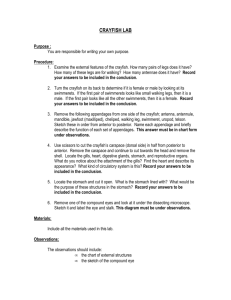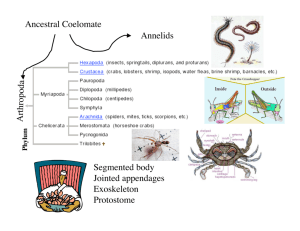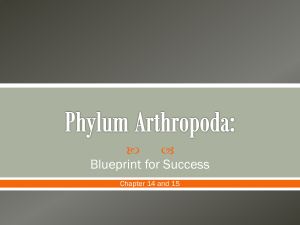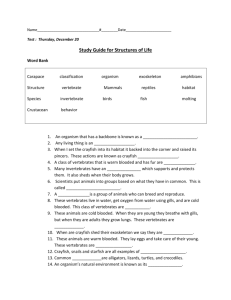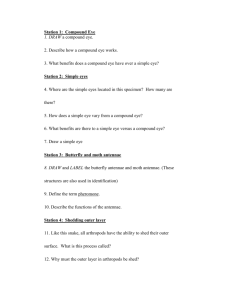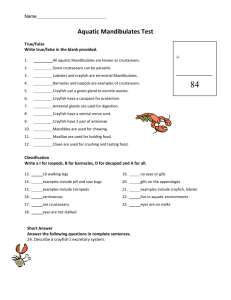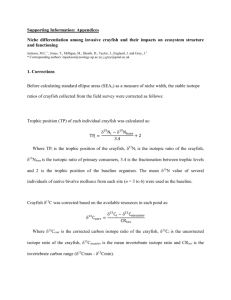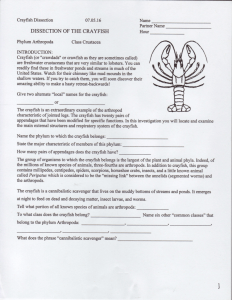BIOLOGY 2/2A
advertisement
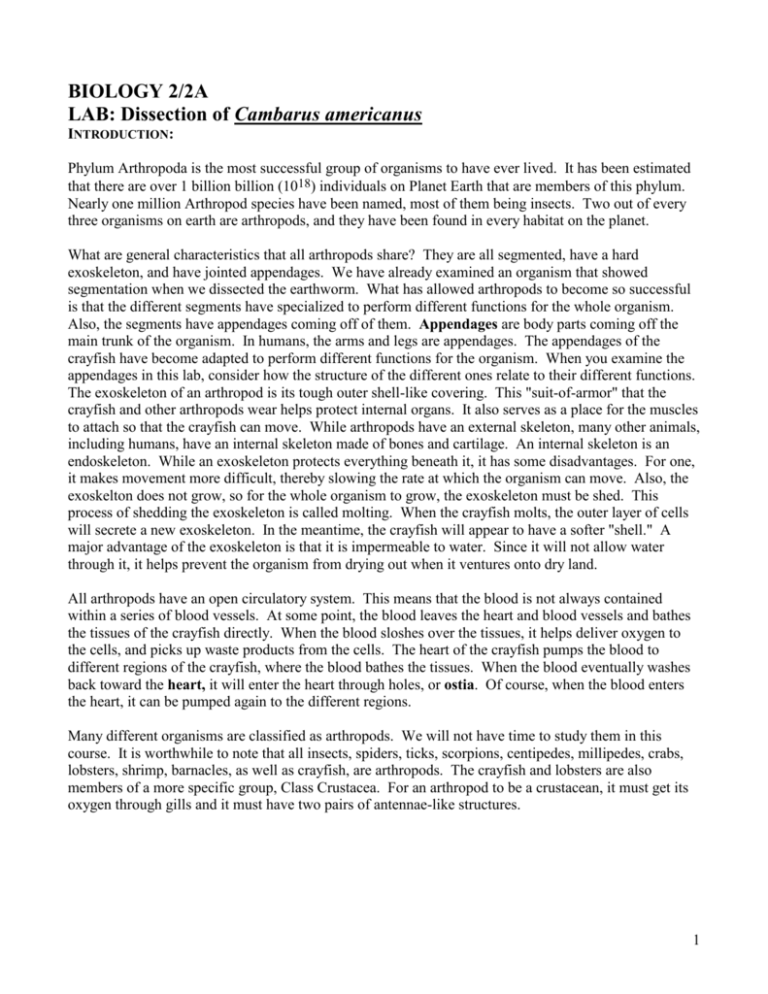
BIOLOGY 2/2A LAB: Dissection of Cambarus americanus INTRODUCTION: Phylum Arthropoda is the most successful group of organisms to have ever lived. It has been estimated that there are over 1 billion billion (1018) individuals on Planet Earth that are members of this phylum. Nearly one million Arthropod species have been named, most of them being insects. Two out of every three organisms on earth are arthropods, and they have been found in every habitat on the planet. What are general characteristics that all arthropods share? They are all segmented, have a hard exoskeleton, and have jointed appendages. We have already examined an organism that showed segmentation when we dissected the earthworm. What has allowed arthropods to become so successful is that the different segments have specialized to perform different functions for the whole organism. Also, the segments have appendages coming off of them. Appendages are body parts coming off the main trunk of the organism. In humans, the arms and legs are appendages. The appendages of the crayfish have become adapted to perform different functions for the organism. When you examine the appendages in this lab, consider how the structure of the different ones relate to their different functions. The exoskeleton of an arthropod is its tough outer shell-like covering. This "suit-of-armor" that the crayfish and other arthropods wear helps protect internal organs. It also serves as a place for the muscles to attach so that the crayfish can move. While arthropods have an external skeleton, many other animals, including humans, have an internal skeleton made of bones and cartilage. An internal skeleton is an endoskeleton. While an exoskeleton protects everything beneath it, it has some disadvantages. For one, it makes movement more difficult, thereby slowing the rate at which the organism can move. Also, the exoskelton does not grow, so for the whole organism to grow, the exoskeleton must be shed. This process of shedding the exoskeleton is called molting. When the crayfish molts, the outer layer of cells will secrete a new exoskeleton. In the meantime, the crayfish will appear to have a softer "shell." A major advantage of the exoskeleton is that it is impermeable to water. Since it will not allow water through it, it helps prevent the organism from drying out when it ventures onto dry land. All arthropods have an open circulatory system. This means that the blood is not always contained within a series of blood vessels. At some point, the blood leaves the heart and blood vessels and bathes the tissues of the crayfish directly. When the blood sloshes over the tissues, it helps deliver oxygen to the cells, and picks up waste products from the cells. The heart of the crayfish pumps the blood to different regions of the crayfish, where the blood bathes the tissues. When the blood eventually washes back toward the heart, it will enter the heart through holes, or ostia. Of course, when the blood enters the heart, it can be pumped again to the different regions. Many different organisms are classified as arthropods. We will not have time to study them in this course. It is worthwhile to note that all insects, spiders, ticks, scorpions, centipedes, millipedes, crabs, lobsters, shrimp, barnacles, as well as crayfish, are arthropods. The crayfish and lobsters are also members of a more specific group, Class Crustacea. For an arthropod to be a crustacean, it must get its oxygen through gills and it must have two pairs of antennae-like structures. 1 External Anatomy of a Crayfish The crayfish has 19 pairs of appendages which are extensively specialized. In early ancestors of the crayfish and other arthropods, all of the appendages were similar in appearance and performed many functions. Over time, these appendages evolved. Their shapes changed, allowing them to perform different functions. Let's now consider the appendages, starting at the anterior (head) end of the crayfish. Before discussing each type of appendage, one must realize that the crayfish has 21 segments. The first 14 segements are combined into one region called the cephalothorax. The cephalothorax is both the head and chest area of the crayfish combined. The exoskeleton of this region is called the carapace. The carapace ends where the easily-noticed segments of the abdomen (tail-region) begin. (1) On the first segment of the crayfish is a pair of compound eyes. The eyes are set on the ends of jointed, movable stalks. Since the crayfish is more active at night, and may not have enough light during the day (if in murky water), the eyes are not nearly as important at sensing the environment than the antennules and antennae. (2) The second segment contains a pair of short hairlike projections called antennules. (3) The third segment contains a longer pair of hairlike projections called antennae. The antennae and the anntenules have many sensory bristles on their surfaces. These bristles not only detect touch, but also detect chemicals, allowing the crayfish to detect food along the bottom, etc. Other appendages have these bristles as well. (4) The fourth segment bears toothlike appendages called mandibles. The mandibles are the jaws of the crayfish. Touching them with the probe during dissection confirms this. To see the mandibles, the crayfish must be turned over on its back. The two mandibles surround the mouth. The mandibles are important organs for crushing food as it enters the mouth. The edges of each are serated, like a steak knife, which helps it cut its food as well. (5) The fifth and sixth segments each contain a pair of maxillae (2 pairs total per crayfish). These appendages are small and lie very close to the mandibles. These mouthparts are important for helping to sweep food in toward the mouth. The maxillae of the sixth segment are also important for helping to circulate water around the gills. (6) The seventh, eight, and ninth segments each contain a pair of maxillapeds (for a total of 3 pair per crayfish). The maxillapeds are important, once again, for moving food to the mouth. The last set of maxillapeds (ninth segment) are quite large and noticeable. They are right in front of the next pair of appendages that have the large claws. (7) The next segment contains the chelipeds. The chelipeds are the appendages that have the large claws at their ends. These are used for both defensive purposes and for capturing prey. It should be noted that crayfish are mostly scavengers, eating dead fish and other organisms. (8) The next four segments each contain a pair of walking legs. The first two pair of walking legs have small pinchers at their ends, which help in capturing and holding on to prey. The last two pairs of walking legs have a sharp fang-like structure at their end. This helps provide traction in walking. The last pair of the walking legs are also used to help clean the appendages of the abdomen. (9) If the crayfish is placed on its back, one can see the appendages on the abdominal segments. The first five abdominal segments have relatively thin appendages called swimmerets. These appendages are used to aid in swimming. The first pair of swimmerets on the first abdominal segment is different in males and females. Males have a very large prominent set of first swimmerets. These are much larger than the remaining pairs and are used to transfer sperm to the female during mating. In females, the first pair of swimmerets are no larger than the other pairs, and are often smaller. In females, the swimmerets not only aid in swimming, but provide a place to attach eggs. The female will carry them with her wherever she goes. 2 (10) The very last part of the tail is a broad, flattened structure called the tail-fan. The tail fan is used for swimming. The large abdominal muscles can contract to pull the tail downward, which will propel the crayfish BACKWARDS through the water. When the crayfish swims it does so tail first. This is usually done as an escape mechanism. Otherwise the crayfish frequently walks along the bottom, head-first. The tail fan is made up of the last segment, or telson. On both sides of the telson are two flattened uropods that also make up the tail fan. The uropods are actually appendages that come from the next-to-last abdominal segment. 3 Internal Anatomy of the Crayfish: The digestive system of the crayfish consists of several different organs. The large prominent stomach has teeth inside it which helps to further break down food that has been ingested by the crayfish. The stomach also serves to store food until it can be fully digested. Food is sorted in the stomach. Small particles are sent into the digestive glands where they are further digested and the building blocks are absorbed. The larger particles are passed on into the intestine, which runs the length of the abdomen and passes the undigested larger particles out the anus. The intestine looks dark, and has often been called a "vein" when speaking about shrimp. When shrimp are "de-veined", they are really having the intestine removed from the fleshy meat of the abdomen that will be eaten. Given the high level of activity of crayfish (and lobsters), one would expect them to need significant amounts of oxygen to carry out aerobic respiration. Water contains less oxygen than air, but the crayfish can get plenty of oxygen because it has numerous gills. The gills are feathery structures that are attached to the walking legs. They lie under the exoskeleton which helps prevent them from drying out when the crayfish is on land. The gills are thin and have a high surface area to facilitate diffusion of oxygen. Blood channels run on the inside of the gills, allowing blood to move through them, picking up oxygen. Having the gills attached to the walking legs helps to circulate the water around the gills, making sure that plenty of oxygenated water comes into contact with them. To get rid of wastes that accumulate in the blood, the crayfish has a pair of green glands that performs a similar function to our kidneys. These green glands are located in the head region of the crayfish, and can be seen more easily once the stomach has been removed from the specimen. The nervous system, like that of the earthworm, is relatively simple. In the head there is a ganglion on the dorsal side that has two nerves running from it to the ventral side, where another ganglion is present. From the ventral ganglion, and whitish ventral nerve cord runs down the length of the crayfish. 4 PROCEDURE: Part One: External Anatomy 1. 2. 3. 4. Place a preserved crayfish on a dissecting tray with the dorsal side up. Notice the hard exoskeleton. The large anterior section of the exoskeleton is called the carapace. Locate it. The carapace covers the fused head-thorax region of the crayfish called the cephalothorax. Locate the cephalothorax region of the crayfish. 5. The segmented posterior of the crayfish is called the abdomen. Locate this body region. 6. At the very anterior end of the carapace is a section that goes between the eyes of the crayfish. This is called the rostrum. Find it. The rostrum helps protect the eyes. To find the following appendages, you may have to refer back to the introduction. 7. Locate the pair of small antennules. 8. Locate the longer pair of antennae. 9. Turn the crayfish and place it on its dorsal side so that its ventral side is facing upward. 10. Locate the two hard, toothlike mandibles. Note the serated appearance. They have ridges like a steak knife on one side to help grind the food. 11. Take your dissecting probe and stick it firmly between the two mandibles. This is the mouth region of the crayfish. Food enters here, traveling to a short esophagus before reaching the stomach. 12. Find the two pairs of small maxillae on either side of the mandibles. 13. Find the three larger pairs of fingerlike maxillapeds near the maxillae. Remember, the largest pair almost looks like a small pair of legs right in front of the chelipeds. 14. Locate the pair of chelipeds. This pair of legs has the large pincers or claws at their ends. 15. Locate the four pairs of walking legs. 16. Locate the swimmerets. 17. Examine the first pair of swimmerets carefully. If this pair is much larger than the rest, your specimen is male, however if it is as small, or smaller than the rest, it is female. 18. Locate the telson, which is the last segment of the abdomen. The telson is the middle part of the tail fan. 19. Find the uropods. There are two uropods on each side of the telson, and they also help make the tail fan. So the tail fan is really five broad parts, one telson and four uropods. 5 Part Two: Internal Anatomy 1. Place the crayfish in the dissecting pan, dorsal side up. 2. Carefully insert the point of the scissors underneath the top of the carapace at the back of the cephalothorax. 3. Cut up the midline of the crayfish, finishing your cut only after you have cut through the rostrum, between the eyes. Make sure you keep the scissors from jabbing down into the organs beneath the exoskeleton. Cut down the sides of the carapace just behind both eyes. 4. Carefully remove the two pieces of the carapace. 5. Notice the feathery gills along the side of the organism. 6. Remove the walking legs and notice that the gills are attached to them. 7. Locate the light colored heart on the dorsal surface just anterior to where the abdomen starts. Unlike our heart, the heart of the crayfish is light colored, and has holes in it to allow blood to enter the heart. These holes are called ostia. Locate them. 8. Remove the heart. 9. Note the two light-colored yellowish masses extending on both sides of the body. These are the digestive glands. 10. Between the digestive glands are a small white pair of reproductive organs, with ducts coming from them in the male crayfish. The female may have a large mass of dark colored eggs in the body, which will have to be cleaned out before proceding. 11. Insert the point of the scissors under the exoskeleton and cut toward the tail fan, making sure not to dig the scissors down into the structures beneath the exoskeleton. 12. Move the pieces of the exoskeleton to the side and notice the dark intestine running down the midline of the abdomen. Also notice the thick white abdominal muscles beneath the intestine. These are the muscles that are mainly eaten when one cooks shrimp or lobster. 13. Trace the intestine anteriorly until it connects with a light-colored baglike structure near the head. This large structure is the stomach. Note that the stomach is durable, but rather thin walled. 14. Remove the organs of the thorax by cutting the short esophagus below the stomach and the bands of muscle holding the stomach just behind the eyes. 15. You should now be able to lift all of the organs out of the thorax in one piece. 16. Cut into the stomach of the crayfish and find the teeth-like structures inside them. Note whether the teeth inside the stomach are serated or smooth. 17. Now look into the head region of the crayfish. Just posterior to, and below the antennules are the green glands. These function like our kidneys. 18. In the front of the head cavity notice the small mass of white tissue. This is the ganglion or brain. 19. Trace the nerves that go from the brain to the antennae and the eyes. 20. Follow the ventral nerve cord from the brain all the way to the abdomen. Remove the muscles of the abdomen to see the ventral nerve cord beneath. The enlarged areas of the nerve cord are called ganglia. 6 ANALYSIS QUESTIONS: #1). What makes the circulatory system of the Cambarus americanus “open”? Describe the circulatory AND skeletal/integumentary anatomy of Cambarus americanus and explain how this form is well-adapted to the specific niche/environmental needs of the organism. #2) Compare/contrast the design of the circulatory system of Asterias rubens (the sea star) with Cambarus americanus. Which design was more “closed” and why is this design necessary for the organism’s lifestyle? #3). Describe the appearance of the gills. How does their physical form and location facilitate their particular function? Explain regarding surface area and attachment to the walking legs. #4) Why are the digestive systems of Cambarus americanus and Asterias rubens similar in regards to their generativity/level of development? What organs were present in EACH ORGANISM for chemical and mechanical digestion (identify separately) #5) Why was the level of nervous system development in the Cambarus americanus different than in another predatory organism, the sea star (Asterias rubens)? Explain how they differed and why 7 ANALYSIS Part II Identify each structure in the picture below and list the SYSTEM to which it belongs. ITEM 1 2 3 4 5 6 7 8 9 10 11 12 13 14 15 ORGAN SYSTEM/FUNCTION 8
